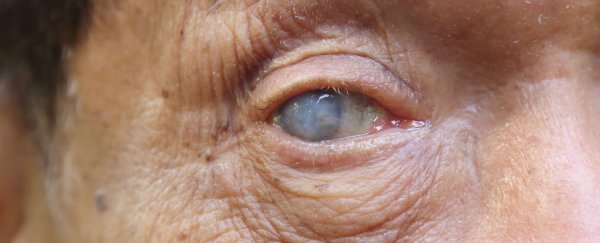Scientists have engineered a biocompatible, light-sensing protein, which they've used to restore daylight vision in mice blinded by an inherited and degenerative eye disease called retinitis pigmentosa.
Millions of people around the world suffer from retinitis pigmentosa and other age-related forms of blindness, such as macular degeneration. These occur when photoreceptor cells in our retinas, which convert light into signals that our brains can decode as vision, stop functioning.
Despite this loss of function, the pathways for vision keep working. This includes another layer of fully functioning cells in the inner retina, known as ON-bipolar cells. The problem is, these cells can't sense light.
A promising new treatment known as optogenetics uses a modified virus to introduce genes that encode light-responsive proteins inside the survivor cells. The aim is to turn them into pseudo photoreceptors and, ultimately, restore vision.
But optogenetic treatments face major hurdles before they can find clinical applications, because they tend to require proteins that only respond to unnaturally high and potentially harmful light intensities, and they rely on foreign signalling mechanism to activate the target cell.
But now, researchers from the University of Berne in Switzerland, say they've engineered proteins that are more compatible with cells in the retina, activating them using natural triggers, which could bring optogenetic therapies one step closer to human trials and medical applications.
"The new therapy can potentially restore sight in patients suffering from any kind of photoreceptor degeneration… [including] those suffering from severe forms of age-related macular degeneration, a very common disease that affects to some degree about one in every 10 people over the age of 65," Sonja Kleinlogel, who leads the university's Optogenetics Lab, said in a press release.
Their hybrid protein, called Opto-mGluR6, consists of two 'ingredient' proteins found in the retina - one from a region that senses light, known as melanopsin, and the other from a signalling region, known as metabotropic glutamate receptor 6 (mGluR6).
As Stavroula Kousta explains for the PLOS blogs:
"mGluR6 is a protein found in retinal ON-bipolar cells that is naturally activated by the neurotransmitter glutamate released from the photoreceptors, thereby amplifying the incoming signal. Because ON-bipolar cells naturally receive direct input from the photoreceptors, turning the native chemically activated receptor mGluR6 into a light-activated receptor means that signaling mechanisms in the ON-bipolar cells are preserved, conferring high light-sensitivity and fast 'normal'responsiveness."
And melanopsin is also resistant to light damage, so the target cells aren't affected by bleaching.
The team demonstrated that by introducing their hybrid proteins into the retinal cells of mice with retinitis pigmentosa, they were able to restore daylight vision.
They have published their results in the journal PLOS Biology.
"The major improvement of the new approach is that patients will be able to see under normal daylight conditions without the need for light intensifiers or image converter goggles," said Kleinlogel. "And retaining the integrity of the intracellular enzymatic cascade through which native mGluR6 acts ensures consistency of the visual signal, as the enzymatic cascade is intricately modulated at multiple levels."
The researchers also say their work could have implications beyond blindness, because the mGluR6 receptor, which their protein takes advantage of, is part of a family of neurotransmitters that are targets for pharmaceutical interventions for conditions such as chronic pain, depression and epilepsy.
Hopefully this work brings optogenetics closer to helping the millions of people with age-related blindness, and the millions more who will develop these conditions over the coming years. And for now, we can be happy for the mice.
